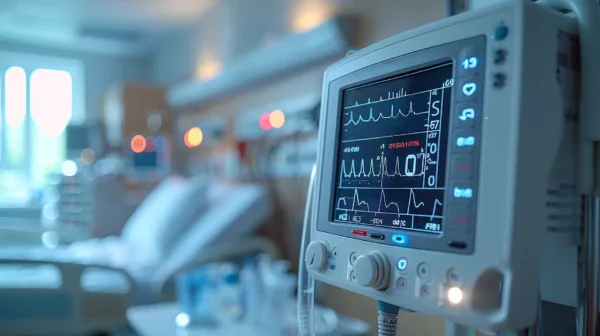SPARC-MONITOR
Medical technology for intensive care units
Ongoing project
Development of a novel analysis monitor for real-time monitoring of cerebral autoregulation and intracranial compliance in patients in the neurointensive care unit.
Ongoing project. Development of a novel analysis monitor for real-time monitoring of cerebral autoregulation and intracranial compliance in patients in the neurointensive care unit.
Background
With the SPARC (Science – Powered – AutoRegulation and Compliance) monitor is intended to monitor cerebral autoregulation and intracranial compliance in patients being treated in a neurological/neurosurgical intensive care unit.
Cerebral autoregulation as a physiological regulatory mechanism describes the brain’s ability to maintain constant cerebral blood flow with variable arterial blood pressure values. This ensures that the tissue is constantly supplied with sufficient oxygen and nutrients. Intracranial compliance refers to the brain’s ability to compensate for volume changes in the intracranial space, for example caused by swelling of the tissue.
Both a disturbance of cerebral autoregulation and a severe restriction of intracranial compliance, which frequently occurs in severe traumatic brain injury and spontaneous intracranial hemorrhage, can lead to a variety of complications, such as brain damage due to oxygen deficiency or an increase in intracranial pressure (ICP). Continuous, bed-side monitoring of both cerebral control mechanisms makes it possible to recognize such complications at an early stage and initiate appropriate therapeutic measures.
Task
The aim of this project is the development of an analysis monitor which, by correlation analysis of intracranial pressure (ICP), arterial blood pressure (ABP) and partial pressure of oxygen (pO2), allows a valid statement to be made about the state of cerebral autoregulation and intracranial compliance.
For this purpose, the dependencies of the oxygen partial pressure under physiological and pathophysiological conditions are investigated and integrated into a mathematical simulation model. Through simulation analyses, correlation patterns between the ICP, the ABP and the pO2 are investigated and defined when simulating different pathophysiological conditions. Based on the simulation results, a corresponding analysis algorithm will then be developed, which will be part of a new type of analysis software.
This obtains the measurement data from the intensive care monitors and makes the results available to the intensive care physician in real time in the form of a holistic, interpretative graphical representation in a suitable form. This is intended to improve the treatment results for these serious illnesses.

Challenge for ASTRUM IT
ASTRUM IT acts as the central project coordinator and is responsible for overall project management. As a certified supplier for medical products, ASTRUM IT also assumes the role of software development partner.
As part of this partnership, ASTRUM IT is developing the entire software architecture for the innovative analysis monitor. Based on the clinical preliminary work, ASTRUM IT is responsible for developing the algorithms and adapting the interfaces.
This project was funded by the Federal Ministry of Economics and Climate Protection (BMWK) as part of the Central Innovation Program for SMEs (ZIM). We would like to thank the project management organization AiF Projekt GmbH for their support. Funding reference number: KK5470602CR3
SUPPORTED BY
Federal Ministry for Economic Affairs and Climate Protection
About the Central Innovation Program for SMEs (ZIM)
PROJECT MANAGER
AiF Projekt GmbH – Project Management Agency ZIM Cooperation Projects
PROJECT PARTNER
Neurosurgery at the University Hospital Regensburg
Neurovisio GmbH

